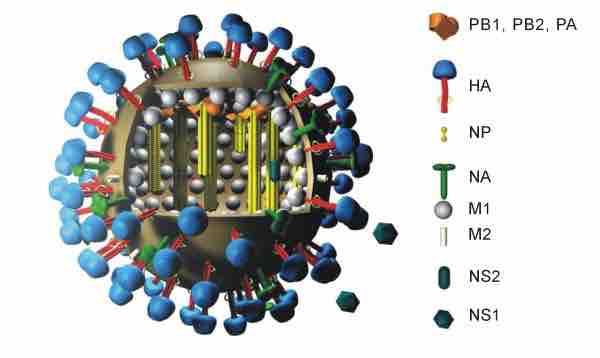One of the best understood examples of virus entry into the host cell is the influenza viral infection. The glycoprotein responsible for attachment on the surface of an influenza viral particle is hemagglutinin (HA). HA is an antigenic glycoprotein. It is responsible for binding the virus to the cell that is being infected. HA proteins bind to cells with sialic acid on the membranes, such as cells in the upper respiratory tract or erythrocytes.

Swine influenza
A depiction of the different structures present on and in an influenza virus. Of special note is HA (hemagglutinin), the glycoprotein critical for influenza attachment and entry into host cells.
HA has two functions. First, it allows the recognition of target vertebrate cells, accomplished through the binding of these cells' sialic acid-containing receptors. Second, once bound, it facilitates the entry of the viral genome into the target cells by causing the fusion of the host endosomal membrane with the viral membrane. HA binds to the monosaccharide sialic acid that is present on the surface of its target cells, which causes the viral particles to stick to the cell's surface. The cell membrane then engulfs the virus and the portion of the membrane that encloses it pinches off to form a new membrane-bound compartment within the cell called an endosome, which contains the engulfed virus. The cell then attempts to begin digesting the contents of the endosome by acidifying its interior and transforming it into a lysosome.
However, as soon as the pH within the endosome drops to about 6.0, the original folded structure of the HA molecule becomes unstable, causing it to partially unfold and release a very hydrophobic portion of its peptide chain that was previously hidden within the protein. This so-called "fusion peptide" acts like a molecular grappling hook by inserting itself into the endosomal membrane and locking on. Then, when the rest of the HA molecule refolds into a new structure (which is more stable at the lower pH), it "retracts the grappling hook" and pulls the endosomal membrane right up next to the virus particle's own membrane, causing the two to fuse together. Once this has happened, the contents of the virus, including its RNA genome, are free to pour out into the cell's cytoplasm.